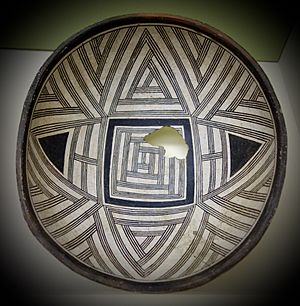Swarts Ruin facts for kids

The Swarts Ruin, also called the Swarts Ranch Ruin, is an important archaeological site. It's located in the Mimbres Valley in New Mexico. From 1924 to 1927, a husband-and-wife team, Harriet S. ("Hattie") Cosgrove and Cornelius B. ("Burt") Cosgrove, carefully dug up the site.
Contents
Discovering Swarts Ruin
Hattie and Burt Cosgrove were not formally trained archaeologists. However, they had watched other digs and even excavated on their own land. The Swarts Ruin project was their first big professional archaeology job. The Peabody Museum of Archaeology and Ethnology at Harvard University paid for their work. Today, many items found at Swarts Ruin are kept safe at this museum.
What is Swarts Ruin?
Swarts Ruin was once a village built by the ancient Mimbres people. These people lived in the American Southwest long ago. The site gives us clues about how they lived. It shows us their homes, tools, and especially their amazing pottery.
The Famous Mimbres Pottery
Before the Cosgroves, people knew a little about Mimbres pottery. But Hattie Cosgrove's work made it truly famous. In 1932, a book called The Swarts Ruin: A Typical Mimbres Site in Southwestern New Mexico was published. This book was the first to clearly describe a Mimbres village.
Hattie's Amazing Drawings
The book became very popular because of Hattie's detailed drawings. She drew more than 700 designs found on Mimbres bowls. These drawings were done by hand with pen and ink. They showed unique and powerful patterns. These designs later inspired many Native American potters. They also influenced other artists across the Southwest.
Dating the Ancient Village
The Cosgroves wanted to know how old the Swarts Ruin was. They knew about a new method called tree-ring dating. This method uses patterns in tree rings to find exact dates. Sadly, they didn't know that burned wood could be used for this. So, they didn't save any charred wood samples.
How They Estimated the Age
Even without tree-ring samples, the Cosgroves made a good guess. They estimated the site was used between 1000 and 1150 CE. They did this by comparing Swarts Ruin to other Mimbres villages nearby. Later, archaeologists used more advanced methods. They found that the village likely ended around 1130 CE. This was very close to the Cosgroves' original estimate!
Swarts Ruin's Lasting Impact
The discoveries at Swarts Ruin had a big impact beyond archaeology. An architect named Mary Colter was very inspired by the Mimbres designs. She used them to create a special china pattern.
The "Mimbreño" China
This china was called "Mimbreño." It was made for the Santa Fe Railroad. From 1936 to 1970, it was used on their famous Super Chief train. Later, it was even used in business class dining cars. People loved the "Mimbreño" china so much that new versions have been made since 1989 for collectors.

